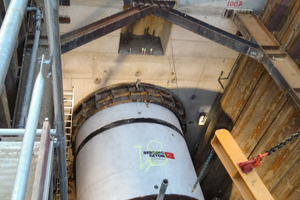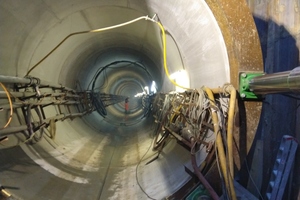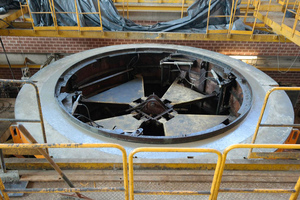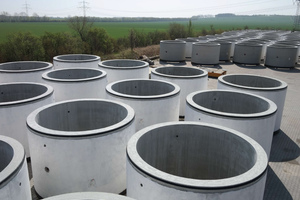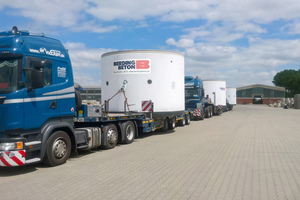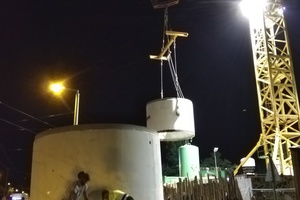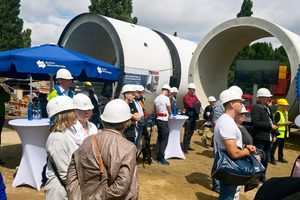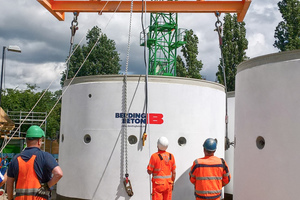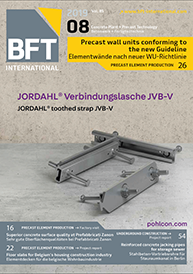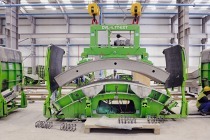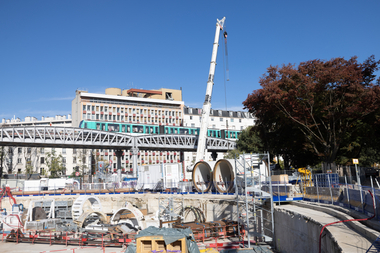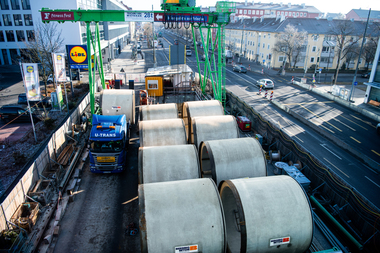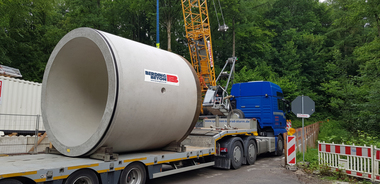Reinforced concrete jacking pipes for storage sewer Berlin Mauerpark
In the Berding Beton Werk in Badeborn, Germany, 218 reinforced-concrete jacking pipes, each 3 m long, with an internal diameter of 3.85 m (ID 3850), an outer diameter of 4.50 m (OD 4500) and an individual weight of 32 tons have been manufactured for an unusual wastewater project in Berlin.
Since the end of 2017, a wastewater project is being implemented in the very heart of the German capital, which is unusual even for a metropolis like Berlin. At a depth down to 12 m, a storage sewer of around 650 m length is currently under construction, directly below the Mauerpark, where part of the Berlin Wall once stood. The Berlin waterworks – Berliner Wasserbetriebe (BWB) – initiated an underground flood protection program already in the 1990s, which provided, among others, for the construction of catch basins and storage sewers. They serve to control large masses of water when the capacities of the pumping stations and wastewater treatment plants are exhausted. Temporary storage of large amounts of wastewater, moreover, reduces obstruction of inflow into the Berlin waterways, thus preventing undesirable pollution of the Spree and Panke Rivers. In the long-term, by 2024, some 300,000 m³ underground storage sewers will have been built in the Berlin sewer network; around 240,000 m³ of which have already been implemented.
On behalf of the client, the Berliner Wasserbetriebe (BWB), construction measures at the Mauerpark have once again increased sewer capacity. Since December 2017, construction has been underway in the district of Prenzlauer Berg, in the center of the inner city, to build Berlin’s largest storage sewer – with a holding capacity of 7,400 m³. The underground storage sewer of 654 m length will be connected to the existing sewerage system. Rain and domestic wastewater, so-called combined water, flows into the sewer. Excess water that occurs during heavy rainfalls in adverse weather conditions accumulates in the connected storage sewer – much like a “parking space” for wastewater. From here, the excess water is subsequently pumped into the wastewater treatment plant.
Maximum performance in terms of planning and logistics
The dimensions of the new sewer are gigantic and call for maximum performance both in terms of planning and of logistics. The company Babendererde Engineers was commissioned with expert supervision of the construction project. The companies Wayss & Freytag Ingenieurbau AG, from Frankfurt, and Stehmeyer and Bischoff Berlin assumed the construction work as the Arbeitsgemeinschaft Mauerpark consortium, which was awarded the bid based on their experience and knowhow. For the project with a volume of 20 million euros, financed to 60 % by the City-State of Berlin and 40 % by the Berliner Wasserbetriebe, the consortium had to face a range of challenges, having to consider in their planning and implementation first of all the restricted area available, the inner-city location as well as utilization of the Mauerpark by people. The continued operation of Tram Line M 10, directly adjacent to the construction site, also had to be ensured, and yet another task was planning rescue operations in case of emergency.
Owing to the naturally existing project parameters, the client had quickly decided on pipejacking as the best-suited construction method. Owing to the underground construction measures involved, restrictions for the people and the environment are kept at a relatively low level. Supported by a high-performance jacking machine, weighing more than 100 tons, the tunnel for the new storage sewer was constructed meter by meter at a depth of 8 to 12 m. Around 20,000 tons of loosened soil were delivered onto the surface above ground. In planning the drilling, the specialized companies also had to take account of geological characteristics, such as the occurrence of tillite and fine sand under pressure in conjunction with stratum water. The high-quality reinforced-concrete pipes are jacked through the constructed tunnel by hydraulically operated jacking cylinders directly behind the Herrenknecht tunnel boring machine.
Pipe production by Berding Beton
The reinforced-concrete pipes were planned and manufactured specifically to the individual specifications and in accordance with the technical regulations of the Berlin wastewater authorities, and by taking into due consideration the geological characteristics encountered. The company Berding Beton was commissioned with production of the reinforced-concrete pipes, since Berding is a specialist in this sector and has the required competence to meet the special requirements of this large-scale project. The 218 reinforced-concrete jacking pipes, each 3 m long, with an internal diameter of 3.85 m (ID 3850), an outer diameter of 4.50 m (OD 4500) and an individual weight of 32 tons, were manufactured in the Berding concrete plant in Badeborn, Germany. The production facilities at the Badeborn site were able to guarantee the client professional implementation, based on its decades of experience with challenging underground construction projects such as the Mauerpark.
The drainage and sewer pipes of acid-resistant concrete C60/75 were manufactured in accordance with high-quality requirements. All the pipes used had hardened in their forms, which ensures especially high dimensional precision and smooth surfaces of the pipes, with the advantage of low mantle friction during jacking. Each pipe is provided with several bentonite lubrication points, which enable the pipe segments weighing many tons to slide easier through the ground. Extension stations additionally ensure frictionless jacking. Encapsulated wedge-form sliding seals ensure perfect function of the pipe connections during the jacking procedure. They ensure, moreover, the stipulated longevity of tightness of the structure over the decades to come.
Nighttime heavy-haul transport
Transportation of the heavyweight jacking pipes alone, with their extraordinary outer dimensions, from the Badeborn plant to the construction site in Berlin required elaborate and professional logistics. Not only because the drivers had to pass through three federal states of Germany, but also, and especially, as very strict requirements had to be observed. One of them provided that the heavy-haul transport was allowed only at night from 10 pm to 5 am, with escort by police.
It was all the more gratifying that the subsequent trenchless pipejacking was implemented within three months without any problem. A special highpoint after completion was the weekend at the end of October, when the interested public was invited to view the storage sewer. On that Saturday, 3,000 visitors took the opportunity to obtain their own impressions during an underground inspection tour.
The storage sewer is scheduled to go into operation at the end of 2019. Installation of a drainage pump in the area of Gleimstrasse, connecting structures to the wastewater disposal areas to both sides of the Mauerpark as well as installation of 19 intermediate manholes for access, cleaning and ventilation are also part of the large-scale project. These works are still underway.
Satisfied statement by all parties involved in the project
Christoph Semrock, overall site manager of the Berlin Mauerpark construction site, is very satisfied with project progress so far: “Collaboration with all parties involved here was excellent and took place hand-in-hand. Our big advantage was that all partners were extensively experienced, which resulted not only in high-level quality of all works, but also in a useful exchange of experience and valuable suggestions during the entire project stage as well. This was essential because observation of all stipulated criteria is of utmost importance, in particular for such a large-scale project,” he said.
And the Berliner Wasserbetriebe arrived at a positive conclusion as well: “Our strategy to renew and develop the infrastructure on a “city-friendly” basis has worked out well with the construction of this storage sewer,” said Frank Etzhold, site manager of the Berliner Wasserbetriebe. “Thanks to the trenchless process, we were able to implement the measure without major obstructions to people, animals or vegetation.”

